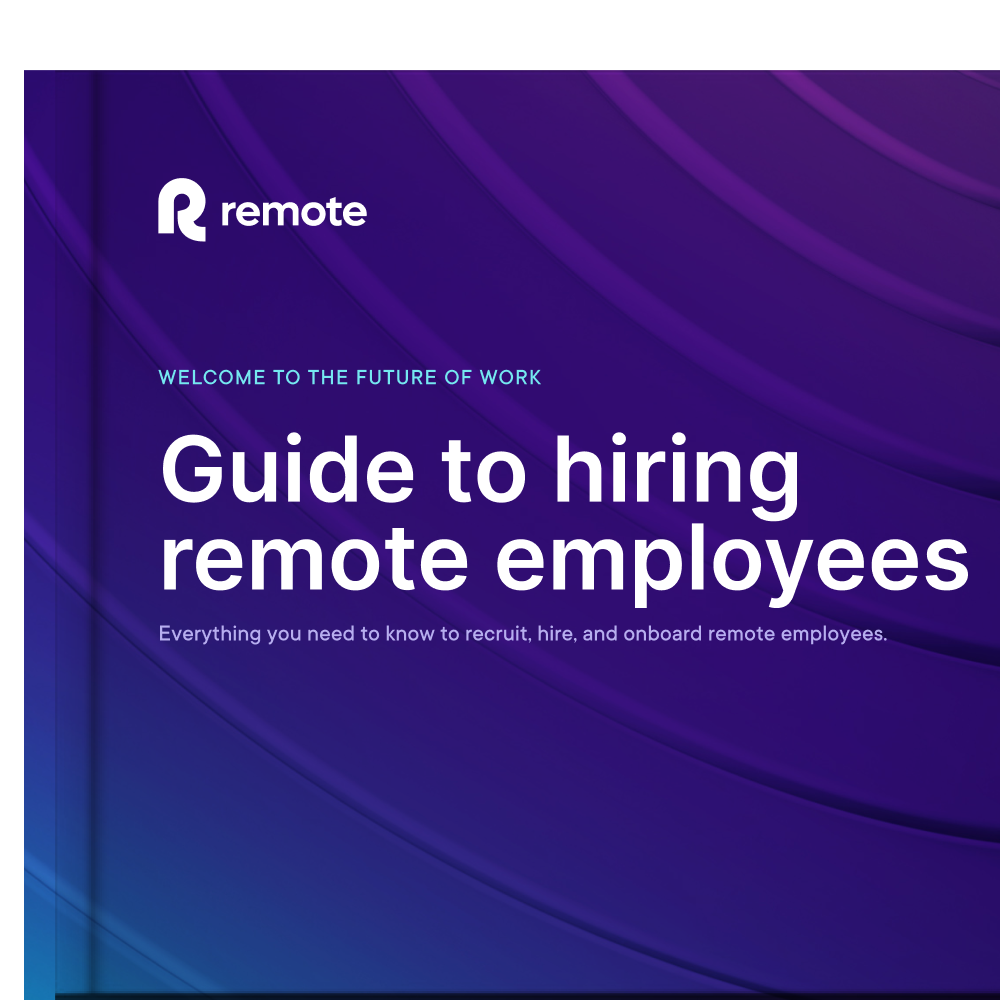
Tax and Compliance — 10 min

The beauty of remote work is that you don’t have to waste hours on the commute. Or take time off to attend a doctor’s appointment. Working remotely gives you the freedom to optimize your workday and develop a healthy life-work balance.
The pros don’t stop at the individual level alone. In addition to creating a flexible and supportive environment for globally distributed teams, remote work has been proven to drive significant cost efficiencies and increase productivity.
However, despite having the independence to work on their own time and in their preferred environment, remote workers are not exempt from the pressures of the modern workplace. Moreover, blurred lines between work and home while working remotely, and the added tendency to work more from home — can lead to stress and burnout.
Working with distributed team members all over the globe can also mean that it can be harder to detect and address signs of work burnout. So, how do you make sure your globally distributed team is getting the most out of working remotely, without suffering from work-from-home burnout?
This article will help you understand exactly that. We’ll take you through the causes of burnout, what work-from-home burnout looks like for remote teams, and how you can help your team deal with burnout at work when it happens.
Work burnout, also called job burnout, is a type of stress associated with work. Often our jobs cause us to become stressed over a prolonged period of time, flooding our systems with chemicals that are really only supposed to be released when a tiger’s about to attack us! When we experience stress over a long period of time, we can end up burning out.
According to the Mayo Clinic, work burnout is a state of exhaustion, both physical and emotional, that can have an effect on a person’s mental and physical health. Burnout was first defined in 1975 by psychologist Herbert J. Freudenberger. He observed that medical workers with heavy caseloads suffered the effects of prolonged stress: exhaustion, depression, and a general inability to cope with stressors.
Although burnout was first recognized as something that can happen to workers in service professions, job burnout can happen to any worker who isn’t getting adequate rest or breaks. Overworking can cause burnouts.
There are a couple of important things to understand about burnout. For one thing, it's not a medical diagnosis. Because exhaustion is a normal reaction to stress and overwork, it’s not a sign of disease. Rather, it’s a sign someone has been working too much.
For another, not all experts agree on how to define or diagnose burnout. Some believe it might be caused or worsened by individual factors, like depression, anxiety, or issues that are happening in a person’s personal life.
Regardless of what causes it, there are three main symptoms associated with burnout:
Exhaustion: People experiencing burnout are tired. It may manifest in physical symptoms like gastrointestinal upset or migraines.
Alienation: When people with burnout are overworked, they may become negative or withdraw from colleagues.
Reduced work performance: You may notice a teammate working longer hours while accomplishing less, or “spinning their wheels” at work.
Managing employee burnout in the workplace is a big part of creating a strong remote work culture.
Learn practical insights from global HR experts at Greenhouse and Remote to help you support your team's life-work balance

Employees can experience burnout physically, mentally, emotionally, cognitively, behaviorally, and environmentally. Work-from-home burnout can show up in one or more of the following ways:
Physical burnout: Physical burnout is probably best seen as exhaustion. It can manifest in other ways, such as the person being clumsy or careless: tripping, knocking things over, or even making more typos than usual. It can also show up as insomnia, which makes an already-tired person even more exhausted.
Emotional burnout: The frustration caused by burnout often surfaces as bursts of emotion in individuals: crying in inappropriate circumstances, or lashing out at co-workers. Workers may also have negative feelings or feel alienated from team members.
Cognitive burnout: When a person is experiencing burnout, they might be unable to work well. They may perceive their work to be dull or routine. Others may observe them in a brain fog or find a lack of creative ideas from them.
Mental burnout: When someone is stressed for a long period of time, they may become forgetful, depressed, or anxious.
There are plenty of benefits to remote work, but working from home has its own stressors. In some cases, remote work can contribute to job burnout. Part of this is the fact that it’s easier to blur the boundaries between work and home life. In a traditional workplace, there’s a clear separation between work and home — you drive to an office, work until it’s time to clock out, and come home to your personal life.
Things don’t work the same way when you’re working remotely and asynchronously. Remote workers may find that they’re working more than they’re supposed to — they might be checking work email when they’re supposed to be off, or spending hours of their personal time working on professional projects. Those workers who do may also be plagued with guilt about spending too much time on work and not enough time with family.
The reverse may also be true. Some workers may experience burnout, by attempting to manage everything at the same time. For instance, they may be trying to juggle the demands of parenting and working from home, or get pulled in to deal with home-related issues. They may go straight from working to dealing with high-pressure family demands with no downtime.
Friends or family, who think “they don’t really work” because they work from home, could impose on them by assuming they have time to babysit or drive someone to an appointment. These kinds of chaotic situations can absolutely contribute to burnout among remote workers.
Reducing stress among remote workers is a big challenge, but there are ways to manage it. Read our helpful guide on how you can help your team reduce stress and burnout.
The pandemic brought a whole new set of challenges to remote workers. Even those accustomed to remote working before March 2020 suddenly found there were new factors in their environment which began to cause stress in their lives.
Family issues: People who weren’t usually home, like kids and partners who normally spent all day in school or work, were sharing space with remote workers. Some workers saw new people move into their space, like new roommates or elderly parents. Some family members came with additional responsibilities, like kids who needed homeschooling.
Financial issues: The pandemic also saw a reshuffling of jobs. People who worked in certain industries, like the hospitality industry or other service professions, were laid off while others, like parents, left jobs to care for family members.
Uncertainty: The early days of the pandemic were stressful due to supply chain issues. Everyone was constantly trying to remain as safe as possible, and this took a toll on everyone, including remote workers.
Illness: The most terrifying part of the pandemic, of course, was COVID-19 itself. Many workers were worried about sick friends and family members and struggled to cope with illness and losing loved ones.
While COVID-19 has now become more manageable, thanks to vaccines, we are still dealing with the stress of the after-effects of the pandemic. The experience of working through a global pandemic still contributes to burnout, especially for those workers who didn't take adequate time off or neglected to focus on mental health.
While the signs of burnout are unique to every individual, there are some common symptoms of work burnout:
Constant busy-ness: If a team member is constantly busy, but not much work is getting done, it can be a sign of burnout. When a worker is spending excessive time on work, but on little else, it could be a warning sign.
Physical symptoms: Constant stress can lead to physical illness. Burnout can manifest itself in the body and the worker may experience illness, aches and pains, headaches, gastrointestinal illness, and sometimes serious issues like high blood pressure or heart attacks.
Mental symptoms: Burnout can lead to mental symptoms such as anxiety, depression, and other mental health issues. Workers who suffer from burnout may become irritable and experience mood swings.
Environmental signs: There are signs in the environments of remote workers that can indicate burnout, according to Jayne Morris, author of Burnout to Brilliance. Examples can include clutter, piles of laundry, dying plants, or physical appliances breaking down due to neglect.
Internal drivers of burnout include a set of thoughts, beliefs, and attitudes that could increase stress and cause burnout. Although each person’s self-talk is different, there are some common patterns of thinking that can lead to feelings of burnout, such as:
Feeling like you always have to be busy: According to Morris, constant busy-ness is one of the most common internal drivers of burnout. You may have internal drivers that tell you to “hurry up,” “keep going,” or “get back to work.” This sort of self-talk often goes back to childhood, when we were told not to dawdle or waste time and get back to back when we were daydreaming at school.
Feeling like you have no control: When a worker feels like they can’t control their workload, or don’t have any control over decisions in their work life, it can take a mental toll on them. This can result in a feeling of powerlessness, like you always have to be switched on at work or at the mercy of others.
Imposter syndrome: Imposter syndrome is the feeling that an individual is a fraud, despite evidence that they are actually quite successful in their field. Recent research suggests that the stress caused by imposter syndrome contributes to burnout. This may be because people with imposter syndrome feel like they have to work twice as hard to be effective at work.
External stressors are the things outside of you that drive burnout, like deadlines, work situations that create stress, or even nonwork stressors, like family life.
Workload: A healthy workload is a good thing for team members. But over recent years, as layoffs have been taking place, some workers have ended up shouldering the work that’s been left behind. Excessive workload is a big contributor to burnout, especially if it seems like the work never stops piling on.
A lack of communication: It’s easy for remote teams to make the mistake of under-communicating. Unfortunately, a lack of communication from a manager can contribute to uncertainty and stress, especially if someone is feeling overwhelmed with work.
No downtime between work and home: Without a commute, remote workers often don’t have a period of decompression between work and home. This buffer can be necessary for workers who need a moment to catch their breath after work. Going straight from working to parenting or dealing with a home issue, for example, can add to the stress.
There are many ways you can start to take care of yourself if you begin to feel like you are burning out at work. Most of these ways involve slowing down, building self-care into your schedule, and creating healthy work habits.
If you’re facing burnout at work, it’s probably time to take a step back and take some time off. If you can, consider taking time off to recuperate. This doesn’t mean taking time off to take care of housework or other responsibilities. It means taking time off to take care of yourself. Do nothing. Your body and mind need a rest.
You don’t need to go anywhere to take time off. You can just take a staycation; remain at home and relax there. This may be the best option for someone who’s facing burnout but wants to avoid the stress of traveling.
Have you ever heard the saying, “If you don’t take a day off, your body will take a day off for you?” It’s true. When your body is constantly flooded with adrenaline, and you aren’t well-rested, you’re more likely to fall sick. You can also get injured if you’re not paying full attention to what you’re doing because you’re stressed, so it’s important to take time off and block days off on your calendar to rest.
If you’re burning out at work, it’s time to speak with your boss. They need to know you’re facing burnout. You may need to ask for time off, fewer responsibilities, or to set boundaries about the time you’re spending at work.
It’s important to take the time out to prioritize your own self-care. It can be hard to do when you are constantly stressed. Morris suggests thinking about an activity we enjoyed as a child. She reminds us that we all knew how to take time out when we were children — we simply played by doing the things we loved.
So, think about what made you happy as a child. If it was art, set aside some time to draw or paint, without worrying about the quality of your creation. If you enjoyed playing video games in your childhood, play a game, even if you haven’t seen Mario or Sonic in decades. Whatever it is that you enjoyed doing as a kid, do it now.

If you’re experiencing total burnout at both work and at home, it’s time for you to take action. Speak with your manager and schedule time off immediately. If you find that you’re resisting the idea of time off, remember that burnout is a health issue. You would take time off if you were physically ill; burnout is no different. Take some time off and do as little as possible – this means enduring a messy house or enlisting partners or family members to take on more chores while you recover.
You should also plan to talk to discuss the problem with someone you trust. It could also be a professional, like a therapist or doctor. Explain what you’re going through, and decide on the steps you can take to ensure you don’t burn out when you go back to work. Read on to find some practical ways to avoid burnout in the future.
At the start of the day, take some time for yourself to determine your top tasks for the day. Rather than trying to focus on several things, choose one or two things that must be accomplished and focus on those.
According to Morris, your body will start to “whisper” to you, but if you don’t listen to your body, it will start to shout. If you need coffee to get moving in the morning, a glass of wine to wind down in the evening, or other habits start to creep in, says Morris, that’s the whisper. A “shout” can look like health problems: headaches, flare-ups of preexisting conditions, or insomnia. If you still don’t listen, you may be headed for bigger health issues down the road, so it’s important to pay attention to your body when you start to see the signs described above.
Saying no is hard to do, especially at work, but setting boundaries is essential. For example, you might choose to say no to a new project if you’re already overburdened with work. It might even be as simple as having hard boundaries around the time you spend working. If you clock out at 5 pm, make sure you stick to that time. This is not always an easy thing to do, especially if you’re mid-project, but you do need that time to rest and recuperate before going back to work the next day.
It can help you to build processes at work that support your self-care, which helps you avoid falling into the same situation again. This could look like a buddy system with a coworker where you keep each other accountable for leaving work at a set time. Alternatively, you could set a specific work routine for yourself or make an agreement with your manager that you won’t take on more than a specified amount of work every month.
Your self-care should be scheduled at the start of your day, just like any other important work task. In fact, Morris suggests that you treat the time taken for daily self-care like an essential meeting. Like you wouldn't skip a meeting with your boss, you shouldn't skip taking time out for your own self-care.
Exercise is an easy way to clear the mind, even if you’re simply going for a walk. Mindfulness and meditation are also excellent stress busters. Schedule some time during the workday for a short mediation session, walk, or workout session. It may seem hard to get up from your desk at first, but you’ll find that your head becomes much clearer after a walk and work becomes easier too.
Your energy is like money; you’ve got a finite amount of it at any given time. Create a spreadsheet to track your well-being, with columns for debits and credits. What tasks have depleted your energy? What activities did you do to give yourself more energy? By visualizing your energy levels on a spreadsheet, you’ll be able to see when you’re not doing enough to boost your energy levels and sense of well-being.
If you want your business to do well, it’s crucial to make sure that your workers are thriving. You need to create a sustainable remote work culture that makes employees feel valued and productive. The following are some ways that leaders can help prevent work-from-home burnout:
Make sure team managers know what to look for when it comes to burnout: is the employee not communicating as much as they used to do? Do they not seem like themselves during meetings? Is their work not up to their regular standards? If managers think they’re seeing burnout, they probably are and should reach out to make sure the employee is okay. For more tips on managing remote teams, read our guide for remote managers.
Every person is different when it comes to communication. Let your team know it’s ok to turn off video for meetings, to use the Do Not Disturb feature on communication platforms like Slack, or to schedule breaks and walks. You can also decide to have Zoom-free days or choose to have video calls just for socialization. Talk to your team about their comfort levels around communication and agree on a plan that works for everyone.
Workers don’t always take the days off they need. Encourage self-care by creating a self-care day for your entire company. On that day, encourage every person in your organization to do whatever they need to do for self-care. Some people may use that day for a spa treatment, some might read, and others might do a physical activity like hiking. Still others might just take a nap. Encourage your team to share photos from their day with the rest of the organization so that everyone can see how their colleagues took care of themselves. The act of sharing also indicates employee accountability.
The most important thing a company can do, says Morris, is practice kindness. If a company doesn’t prioritize kindness, it becomes difficult for workers to be kind to themselves. You can’t expect workers to practice self-care if the organization doesn’t encourage a culture of self-care. This also means leaders should be practicing self-care for themselves, and modeling what self-care looks like for their teams.
“It has to be something you recognize in your superiors,” says Morris. “If they’re not practicing kindness for themselves, it’s hard for you to feel you have permission to practice kindness for yourself.”
Another reason it’s essential for leaders to practice self-care? It’s hard to be kind to others if you’re not being kind to yourself. “It’s a bit like putting on an oxygen mask on a plane,” says Morris. “You need to put it on yourself before you can put it on anyone else.”
Learn more about building a foundation for sustainable and healthy remote employee experiences in our guide to creating remote work cultures.
In the book Gift from the Sea, Anne Morrow Lindbergh writes about self-care in terms of pitchers: when you’re always pouring your pitcher out and never stop to refill it, the pitcher will run dry. You’ll have no energy left to give to anyone, including yourself.
It may seem difficult or selfish to take time off to care for yourself, but if you’re experiencing burnout, you’re probably not being the best employee possible. It’s important to stop, take care of yourself, and refill your pitcher. Work will still be there when you return to it after a period of rest, but remember — you are a finite resource.
Learn the processes you need to find, recruit, and onboard remote employees (and stay compliant while you're at it).

Subscribe to receive the latest
Remote blog posts and updates in your inbox.